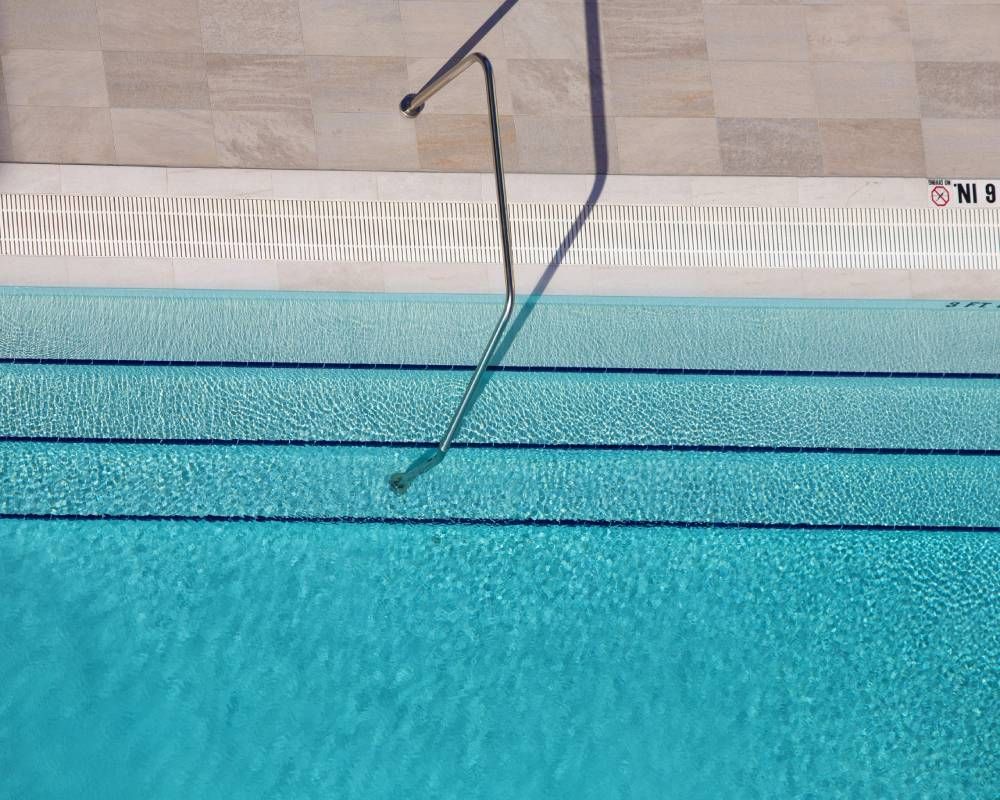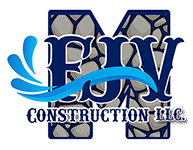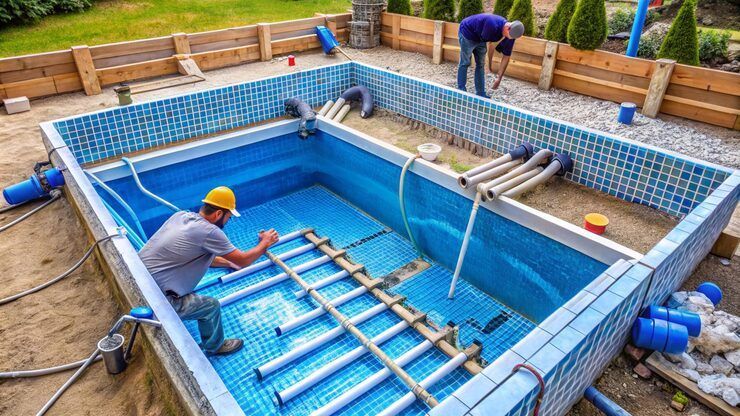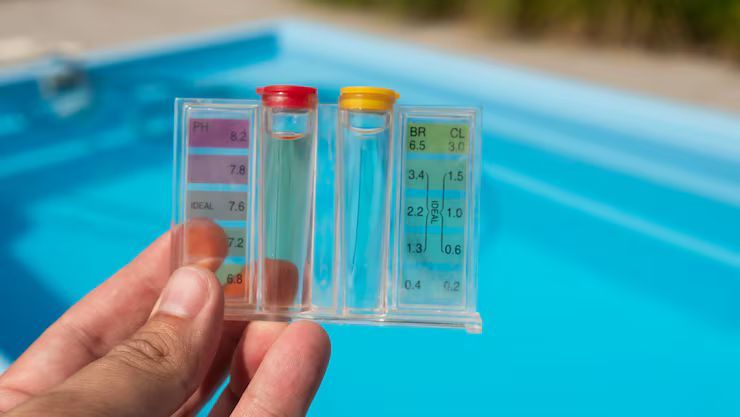Cracks in Your Inground Pool? Here’s How to Repair Them Fast
Inground pools are a major investment, especially in sun-soaked places where they see year-round use. However, cracks can form over time due to shifting ground, age, or plumbing issues—and they often show up when least expected. Even small cracks can lead to serious water loss, equipment strain, and expensive repairs if left unchecked.
Here are five fast, effective steps to identify and fix cracks before they get worse.
Table of Contents
- Key Takeaways
- 5 Effective Steps to Identify and Fix Cracks in Inground Pool
- 1. Start with a Visual Inspection
- 2. Run a Simple Bucket Test
- 3. Check the Pool Equipment Area
- 4. Use Temporary Fixes to Slow the Damage
- 5. Schedule a Professional Inspection and Repair
- How to Tell If a Crack Is Cosmetic or Structural
- How to Spot Early Plumbing Leaks That Could Lead to Cracks
- How to Maintain a Repaired Pool to Prevent Future Cracks
- Frequently Asked Questions (FAQs)
- Fix Pool Cracks Fast with FJV Construction in Danbury, CT!
Key Takeaways
✔ Small pool cracks can lead to major structural damage if not addressed early.
✔ A simple bucket test can help confirm whether water loss is from evaporation or a leak.
✔ Plumbing leaks often show up as air bubbles, pressure changes, or wet spots near the deck.
✔ Temporary crack fixes like epoxy can prevent further damage until a pro steps in.
✔ Regular inground pool maintenance and repair helps prevent future cracks and costly repairs.
✔ Equipment issues often link to plumbing stress, requiring pool filter and pump repair.
✔ Professional inspections ensure cracks, leaks, and plumbing problems are fully resolved.
5 Effective Steps to Identify and Fix Cracks in Inground Pool
1. Start with a Visual Inspection
Before calling in experts, start with a careful look around the pool area. Cracks don’t always scream for attention—some start small and widen over time. Spotting them early can help reduce the cost of inground pool leak repair down the road.
How to Visually Check for Damage That Signals a Bigger Problem
- Look for Surface Cracks in Plaster or Concrete: These might seem harmless, but even hairline cracks can signal pressure shifts or structural strain. Left alone, they can allow water to seep behind the surface and weaken the pool shell.
- Check the Tile Line and Expansion Joints: Gaps or broken tiles near the top edge of the pool often show up when the concrete underneath shifts or settles. These areas are more than cosmetic—they help manage movement between materials and protect against bigger breaks.
- Watch for Waterline Drops and Stains: If the water level drops quickly or dark streaks appear around a crack, it may point to an active leak. This is often a sign that it’s time to call a specialist for inground pool repair near you in Danbury, CT, especially if the issue continues after a refill.
2. Run a Simple Bucket Test
A bucket test is one of the easiest ways to confirm whether water loss is caused by evaporation or an actual leak. It takes just a few minutes to set up and can save time by narrowing down the problem. For anyone concerned about undetected cracks or water loss, this step can point directly to the need for inground pool leak repair.
How to Use a Bucket Test to Identify a Leak
- Fill a Bucket with Pool Water and Place It on a Step: Use a weighted bucket filled three-quarters of the way with pool water, then place it on the second pool step so it's partially submerged. Mark the water level on both the inside and outside of the bucket using waterproof tape or a marker.
- Turn Off the Pool Pump During the Test: Let the system rest for 24 hours so the water settles naturally. This creates a clean environment to compare evaporation in the bucket against water loss in the pool itself.
- Compare Levels After 24 Hours: If the pool water level drops more than the bucket’s, a leak is likely present. At that point, it’s smart to search for inground pool repair near me in Danbury, CT, to stop further damage and water waste.
3. Check the Pool Equipment Area
Not all cracks show up in the shell—some start in the equipment zone. A hidden leak in pipes, fittings, or valves can lead to serious water loss and rising energy bills. Checking the equipment is a big part of overall inground pool maintenance and repair and should never be skipped.
How to Spot Equipment Problems That Might Link to Cracks
- Inspect Plumbing Lines and Connections: Look for moisture, corrosion, or wet spots near pipes and connections. Cracks in PVC lines or seals can cause leaks that look like pool surface issues but are actually related to inground pool plumbing repair needs.
- Listen for Air or Gurgling Sounds: If air enters the system, it might mean there's a suction-side leak. Strange sounds in the pump or bubbles in the return lines are often early signs of plumbing problems that connect back to hidden cracks.
- Check for Leaks Around the Filter and Pump Housing:
Water pooling near the base of equipment or visible drips from joints may indicate failing seals or cracked fittings. Quick action can prevent full system failure and reduce the cost of pool filter and pump repair.

4. Use Temporary Fixes to Slow the Damage
When a crack is visible but help can’t arrive right away, a temporary patch can stop things from getting worse. Quick fixes aren’t permanent but can give enough time to plan a proper repair. This is especially helpful during peak season when inground pool leak repair services may be booked out.
Short-Term Solutions That Can Protect Against Bigger Problems
- Seal Surface Cracks with Epoxy Putty: Waterproof epoxy can hold up underwater and bond to concrete or plaster surfaces. It’s a reliable short-term fix for surface-level cracks until professional inground pool maintenance and repair services step in.
- Apply
Underwater Vinyl Patches for Liners: For vinyl pools, patch kits work well on small tears or splits. The adhesive holds underwater and slows leaks, giving homeowners breathing room before full liner replacement or deeper plumbing inspection.
- Use Foam Backer Rod for Expansion Gaps: When gaps form in the expansion joints, inserting foam backer rod can fill the void and reduce movement. Follow it with silicone sealant to keep water from seeping into the gap and creating more structural stress.
5. Schedule a Professional Inspection and Repair
Temporary fixes help, but a permanent solution requires expert tools and trained eyes. Professionals use pressure testing, underwater cameras, and advanced sealing methods to track and repair damage. This is especially important for issues tied to plumbing systems or those involving pool filter and pump repair.
How Professionals Address the Root Cause of Cracks
- Performs Leak Detection with Pressure Testing: Certified technicians isolate sections of plumbing and apply pressure to identify weak spots or hidden breaks. This method is crucial for diagnosing problems that point to inground pool plumbing repair.
- Injects Resin or Staples for Structural Crack Repairs: Deep structural cracks require reinforcement through staples or high-strength polymer injections. These materials bond tightly to concrete and restore strength, helping avoid recurring damage.
- Services Equipment That Supports the Pool System: Often, cracks and equipment issues go hand in hand. Replacing damaged seals, upgrading filters, or fixing a broken impeller as part of a pool filter and pump repair can restore the system’s performance and extend the pool’s life.
How to Tell If a Crack Is Cosmetic or Structural
A pool's return on investment (ROI) ranges from 5% to 56%, making proper maintenance essential to preserving its value. However, not all pool cracks are the same—some are minor surface flaws, while others indicate deeper structural issues. Identifying the difference early helps protect your investment and minimize the need for costly inground pool leak repairs.
1. Check the Depth and Width of the Crack
A shallow, hairline crack that’s less than 1/8 inch wide is often cosmetic, especially if it only affects the plaster. However, if the crack feels deep or has jagged edges, it could be structural and may require immediate attention. Deeper cracks can allow water to escape and often lead to inground pool plumbing repair if left untreated.
2. Watch for Water Loss Over Time
A cosmetic crack won’t typically impact water levels, but a structural one might cause a steady drop. If the pool loses more than a quarter-inch per day, even after accounting for evaporation, it’s a clear sign of a potential leak. In these cases, scheduling inground pool leak repair should be a priority before further damage spreads.
3. Inspect for Cracks Near Fixtures and Returns
Cracks that form near drains, lights, or return jets often indicate plumbing-related issues beneath the surface. These types of cracks are rarely cosmetic and may signal movement in the pool shell or damage to underground lines. This situation usually requires a full inspection and may lead to inground pool plumbing repair or even excavation work.
4. Monitor for New Cracks After Repairs
If new cracks appear shortly after a recent repair, it may suggest unresolved structural stress or shifting ground. Surface patching alone won’t fix deeper instability that could impact plumbing and filtration systems. Bringing in a technician skilled in inground pool maintenance and repair helps ensure the original problem is fully addressed.
5. Look for Bulging or Uneven Pool Walls
Any swelling or misalignment in the pool walls is a major red flag that something beneath the surface has shifted. Structural cracks often create visible distortion in the shell or surrounding deck, especially after heavy rains or settling. Ignoring this can damage circulation lines and require costly pool filter and pump repair in addition to structural work.
6. Pay Attention to Staining and Discoloration Around the Crack
Dark streaks, rust-colored marks, or mineral buildup near a crack often signal long-term water escape. These stains typically develop when water seeps through structural cracks and reacts with soil or metal fixtures. When this happens, it’s best to contact an expert offering inground pool repair near you in Danbury, CT, to assess whether the damage runs deeper than it looks.

How to Spot Early Plumbing Leaks That Could Lead to Cracks
Plumbing leaks don’t just waste water—they can quietly cause structural damage to an inground pool. Left unnoticed, they may erode soil, weaken the foundation, and create pressure that leads to cracks in the pool shell. Catching these warning signs early can help avoid the need for major inground pool plumbing repair or emergency structural work.
1. Listen for Unusual Sounds from the Equipment Area
A humming pump is normal, but hissing, gurgling, or slurping sounds could mean air is entering the system through a leak. Suction-side leaks pull in air, which can disrupt water circulation and eventually cause stress on the pool walls. These issues often lead to early pool filter and pump repair and require a technician to pressure test the plumbing lines.
2. Watch for Bubbles in the Return Lines
Air bubbles coming from the return jets aren’t just cosmetic—they often mean a plumbing leak is letting air into the system. If the bubbles appear consistently, it may indicate a small crack in the suction piping or a faulty seal. This type of problem, if ignored, can damage circulation and call for full inground pool plumbing repair.
3. Check for Wet or Soft Spots Near the Pool Deck
A damp area around the pool, especially one that never dries, could be a sign of an underground leak. Water escaping from a cracked pipe can erode the surrounding soil and shift the pool’s support system. This often sets the stage for structural damage that requires both inground pool leak repair and concrete resurfacing.
4. Monitor the Pool Filter’s Pressure Gauge
A sudden spike or drop in pressure can mean something’s not flowing as it should. Low pressure might indicate a suction-side leak, while high pressure can result from a blockage or air bubble. These changes often point to leaks or equipment strain, requiring pool filter and pump repair to avoid long-term damage.
5. Look for Sudden Increases in Water or Energy Bills
When plumbing leaks go unnoticed, water escapes continuously, forcing pumps to work harder and run longer. This raises utility costs and puts extra wear on the system, especially the filter and pump. A professional offering inground pool repair near you in Danbury, CT, can quickly trace the source and make targeted repairs before costs climb further.
6. Inspect the Skimmer and Main Drain Closely
Hairline cracks or shifting around the skimmer and main drain can allow water to bypass the intended path. These leaks can cause soil erosion and lead to uneven pressure on the pool walls, increasing the risk of cracks. In many cases, targeted inground pool maintenance and repair can seal the damage before it turns into a full structural issue.
How to Maintain a Repaired Pool to Prevent Future Cracks
Fixing a crack is only half the job—what happens afterward can determine whether the repair holds or fails. That’s why ongoing care is essential to avoid repeated inground pool leak repairs. As demand rises—reflected in the swimming pool market’s projected growth of over 3% from 2025 to 2030—establishing a strong, professional maintenance routine becomes even more critical to protecting your investment.
1. Keep Water Chemistry in Balance
Unbalanced water can erode pool surfaces and corrode plumbing, especially when pH or calcium levels swing too far. Soft water eats away at plaster, while high acidity can degrade seals and fixtures. Regular testing and adjustments—often included in inground pool maintenance and repair services—prevent costly structural and equipment damage.
2. Maintain Proper Water Levels
Water that drops too low exposes surfaces to air, leading to drying, cracking, and shifting pressure. On the other hand, water that’s consistently overfilled can flood skimmer boxes and strain pumps. A reliable service offering inground pool repair near you in Danbury, CT, can monitor levels during routine visits to help keep everything in check.
3. Inspect the Pool Shell and Deck Seasonally
Even after a repair, seasonal shifts can create new pressure points or reveal subtle surface changes. Inspecting the shell, expansion joints, and deck at the start and end of each season helps catch problems early. Small issues can be addressed with quick inground pool maintenance and repair before they turn into deeper cracks.
4. Schedule Regular Equipment Tune-Ups
Faulty equipment puts unnecessary strain on plumbing and circulation systems. A worn-out pump or clogged filter can alter water flow, creating pressure that pushes on weak areas of the pool shell. Proactive pool filter and pump repair keeps the system running efficiently and helps prevent future stress cracks.
5. Winterize the Pool Correctly, Even in Mild Climates
In warmer areas, winter damage might seem unlikely, but cold snaps can still impact exposed plumbing and surfaces. Proper winterizing includes draining select lines, checking fittings, and balancing chemicals to prevent freeze-thaw damage. Partnering with an inground pool plumbing repair expert ensures seasonal prep is done right.
6. Work with a Trusted Professional for Ongoing Care
DIY fixes might work short term, but a professional has the tools and training to spot risks before they grow. Ongoing service plans often include detailed inspections, water testing, and system maintenance. Choosing experienced help for inground pool maintenance and repair builds long-term stability and helps avoid another round of repairs.
Can landscaping around the pool cause cracks?
Yes, tree roots and improper grading around the pool can shift soil and put pressure on the pool shell. This can lead to surface cracks or even hidden damage that results in leaks over time. To prevent future issues, professional inground pool maintenance and repair should include a review of landscaping risks near the pool structure.
How long does inground pool crack repair typically last?
When done correctly by professionals, a structural crack repair can last 10 years or more. The lifespan depends on material quality, soil conditions, and whether proper inground pool maintenance and repair is done consistently. Periodic inspections can extend the durability and reduce the chances of needing inground pool leak repair again.
Are fiberglass pools less likely to crack than concrete ones?
Fiberglass pools are more flexible and generally resist cracking better than concrete pools. However, plumbing issues or poor installation can still cause stress points that lead to damage. In either case, prompt inground pool plumbing repair is essential to avoid pressure buildup that damages the shell.
Can a crack in the pool affect water clarity or color?
Yes, even a small crack can affect water clarity if it allows soil or contaminants to enter the system. This can strain the filter and increase the need for pool filter and pump repair. Discolored water may be an early sign that the pool is leaking or drawing in debris.
Should insurance cover inground pool crack repairs?
Some homeowner policies may cover inground pool repair near me in Danbury, CT, depending on the cause of the damage. However, wear and tear or lack of maintenance is typically excluded. It's always best to check with the provider and schedule regular inground pool maintenance and repair to stay ahead of costly surprises.
Fix Pool Cracks Fast with FJV Construction in Danbury, CT!
FJV Construction brings trusted experience and fast results to every inground pool repair in Danbury, CT. From stubborn leaks to complex plumbing damage, our team handles everything from inground pool maintenance and repair to full pool filter and pump repair with precision. We specialize in identifying the source of cracks, restoring structural integrity, and keeping pools running smoothly all season long.
Don’t wait for damage to spread—contact FJV Construction for expert inground pool leak repair today!



